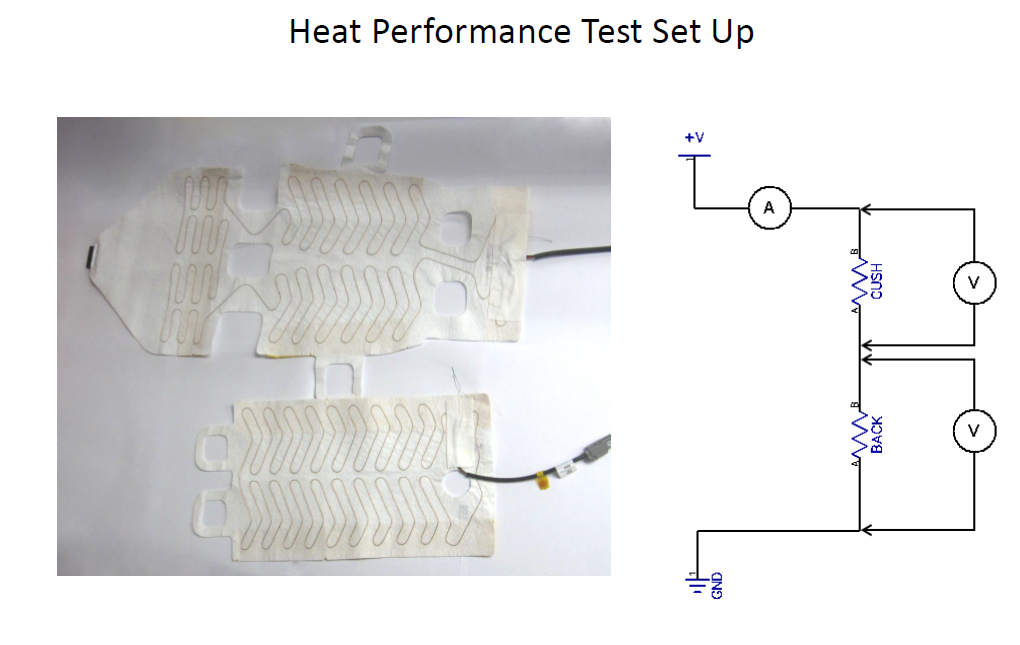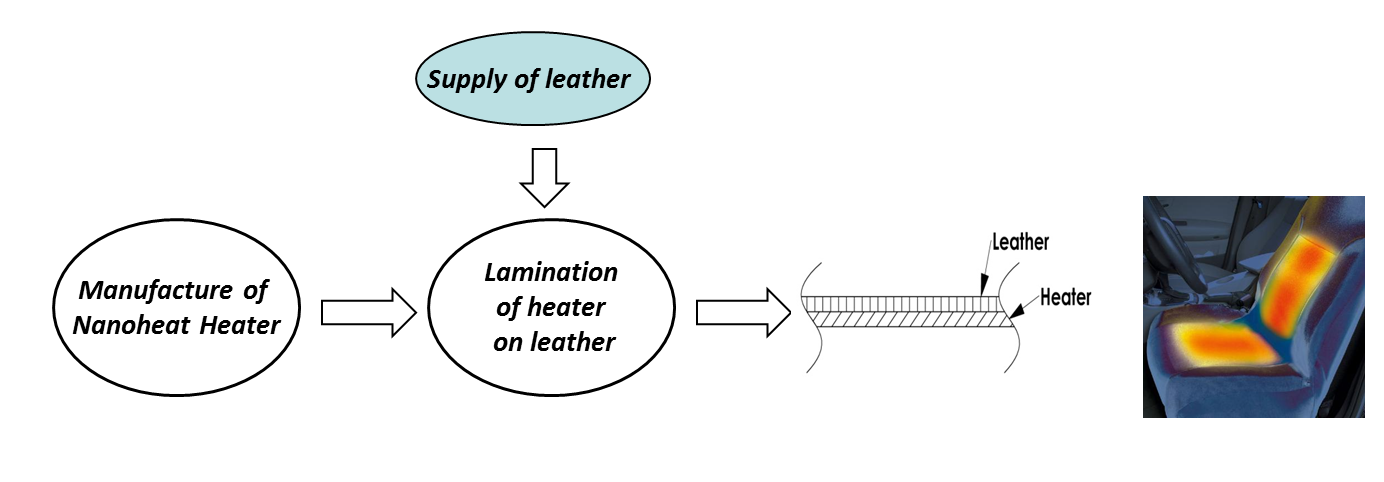Nano Heater Technology Application to provide flexible heating for Automotive Interiors and other consumer applications
Further progress on Soft Nano Heater Flexible Heater. Thickness only 0.75 mm and Heater Power is 48W at 13.5V.
Thermal image as shown below. With higher power heating time can be increased, if desired.
AME Nano Heater has multiple applications going forward in 2018 and 2019. Autonomous vehicle seating creates other applications especially when it comes to people movers where cleanliness will be imperative.
Printed AME heaters on cloth has passed quality and safety testing for automotive. In addition, strong business case has been proven for faster heating and 35% cost reduction over current wire heaters.
Below are two more applications recently identified and concept design completed:
- Nano heating for 1 year or younger child pram and child back pack carriers.
- Heated Seat Covers with printed Nano Heaters.
Successful technology validation of the Flexible Nano Heater for heating applications as below:
- Heated undergarments: Heating from ambient of -20C to 42C in < 3 minutes.
- Heated vests for dogs: Provide warmth on cold days.
- Automotive and Steering Wheel: 42C in < 3 minutes.
- Voltage 12.3v with current of 4A.
For Automotive applications, especially autonomous people movers, if we integrate super-capacitor can warm seat to 42C in under 90 seconds providing warmth on cold day quickly.
Flexible Nano Heater printed on cloth – size 320 mm x 227 mm successfully achieved uniform temperature distribution. Designing to following ideal functions:
- In 20C ambient flexible Nano Heater to reach temperature of 40C +/- 5% in less than 2 minutes.
- Low power consumption.
- Even heat and temperature distribution.
Initial test samples were pattern design covered the entire 320 mm x 227 mm. The temperature variance was less than 5% but time to heat was more than 5 minutes.
Current design has heating film to allow gaps (interspace) between heating tracks of 10 mm to re-distribute heat energy on the track areas and speed up the heating time. Adjusting the film composition in reducing sheet resistance (improvement of conductivity) and improving heat transfer.
Over the last few years innovative material and coating systems for high performance & energy saving heating activities for consumer lifestyle, automotive and medical applications have been developed. Below is the progress made by Design HMI working with innovators like AME, DuPont and others.
NanoHeat® Product Niche:
- Award winning patented technology and design
- Patented technology utilized by European top brands (Morphy Richards, Bugatti) in creation of world first innovative products
- Well sold in Hong Kong top premium shops and well received by middle class customers
- Well received by top corporates and selected for corporate and event gifts, including Richemont of Swiss, Wall Street Journal of US, Exxon Mobil, and Hong Kong Science and Technology Parks Corp.
Firsts for AME:
- World First Transparent Glass Heater Toaster by Morphy Richards, Product Launch in IFA Fair Berlin Germany, Sep 2015.
- World First Transparent Glass Smart Cookware by Casa Bugatti, 2016.
- Successful production intent prototypes for automotive.
Current in Market Heated Seats
A analysis done by one innovator on the 2001 Range Rover as the seat was not heating enough to his wife’s satisfaction.
The heater wires are sandwiched between two layers of thin foam glued together with a mild adhesive with a thermal switch. The thermal switch controls seat temperature but it turned off when the temp. at the sensor reached 92 degrees F and didn’t turn back on until the temp. had dropped all the way to 78 degrees F. And these temps are INSIDE the seat. The temp. at the surface of the seat cushion is much lower and just heat was just perceptible. Basically, the heater would heat mildly once, and then never come back on since it would never drop back to 78 degrees.
He simply swapped for a new 45 degrees C thermal switch that regulated the heat better. It now heated to 113 degrees F max temp, and more importantly, the new switch turned back on at 91 degrees F. So, now the temp never falls below 91 degrees.
For more information click (http://www.rangerovers.net/repairdetails/seats/seatheat4upgrade.html)
REMARKS: Better next generation heater would be to have thermal heater as safety circuit only and have the heater wires designed to be self-regulating. Also the heater element has to be closer to the B side of the seat fabric / leather.
Currently AME Nano Heating technology application is progressing and initial test set up to determine reliability and quality as below.
Click http://www.ames.hk/ For More Information
NanoHeat® is a new generation of heating element in Nano-thickness (1 m = 109 nm), capable to provide fast and high efficiency heating functions in cold weather.
NanoHeat® is built with ultra-low electrical resistance, capable to be driven with simple direct connection to D.C. power source, car battery and even supercapacitor for fasting warming, ice melting and defrosting.
NanoHeat® produces no magnetic emission and interference for environmental improvement, and thus removes hazards & interference to surrounding equipment and devices, currently the technology is applied in products for laboratory uses.
NanoHeat® is reliable and tested fully at high voltage and high wattage uses by top electronic consumer product companies in the past four years in innovative product development.
Nano Heating Technology for Defrosting Exterior Rear View Mirrors:
Technical Challenge: Current limit: 5A, i.e. ~65W
Design Steps: Two approaches will be considered for next steps.
- Differential Heating – AME is to build a Nano Heater with different power outputs, thus different temperatures in different areas to the mirror. From past test experience, once a segment of ice was melted, ice melting would be speeded up across the whole area.
- Super Capacitor: Nano Heater with different power inputs, top section with Super Capacitor and bottom section with DC battery.

Results from the Differential Heating Ford Rear View Mirror Prototype:
Sample was built up and tested based on the following Nano Heater Design Specifications:
- 3 mm thick Nano Heater of ~1.6-ohm electrical resistance.
- Power Output ~ 65 W, operating at 10 V DC supply with 6.5A max.
- Test Conditions: Ambient 40C inside Freezer.
- Ice Quantity Approx. 50 g (Solid Ice)
Conclusion to Differential Testing
Nano Heater with differential heat capacity successfully melted and almost cleared all ice over the mirror in 4 minutes at power of 65W (based on 13V & 5A requirement). Top layer of ice started to melt after 1 minute and 45 seconds, faster than prior test.
Flexible Nano Heaters from AME have been successfully made on fabric with satisfactory performance meeting the technical requirements of Automotive. There are some ideal applications like in the case of vehicle driver and passenger seats.
Production Flow for Manufacture of Heated Driver Seat Heater:
Advantages of Nano Heating Technology:
- No magnetic interference.
- Easy to package / laminate to different surfaces and materials.
- Eco-Friendly as few grams of material in its construction as compared to up to 1kg of metal in induction coil construction.
- Energy Saving due to higher efficiency.
- 99% energy efficiency in dynamic heat transfer / 90% in static heat transfer. 75-85% energy efficiency in IH; 65-75% energy efficiency in radiant heating.
- Adaptable for D.C & Renewable Energy Sources with very low electrical resistance; able to be driven by battery & D.C. power.
- Nano Thickness.
- Potential application in medical & therapy devices.
Nano Heat is classified as One-Dimensional Nanomaterial system
Contact designhmi@gmal.com for application details.
AME Flexible NANO Heaters have been successfully made on fabric with satisfactory performance to meet Automotive Technical Requirements.
A full prototype of steering wheel, mounted with the flexible heater and the temperature control circuit which limits the maximum surface temperature of the steering wheel at 40oC, was evaluated.
Improvement on mounting of the heater on the steering wheel are being made for ease of assembly and more uniform hear distribution.



































I’m amazed, I have to admit. Seldom do I come across a
blog that’s equally educative andd entertaining, and without a doubt,
you’ve hit the nail on thee head. The problem is something too few folks are
speaking intelligently about. Now i’m very happy that I found thius
during my search for something regarding this.